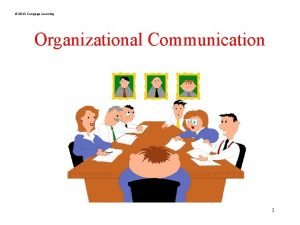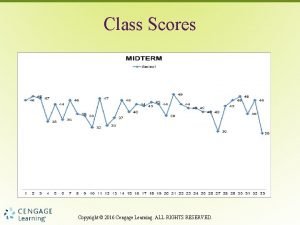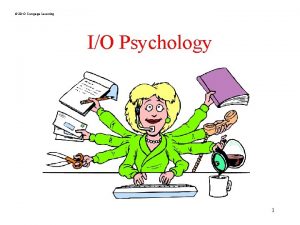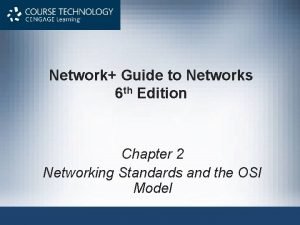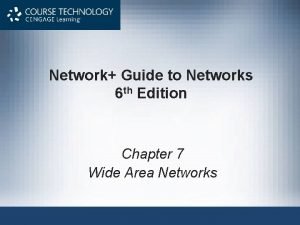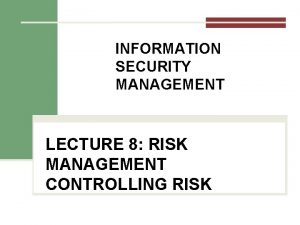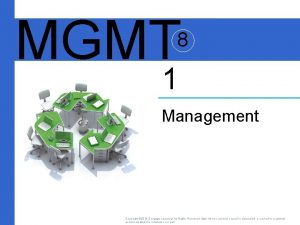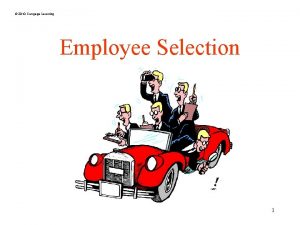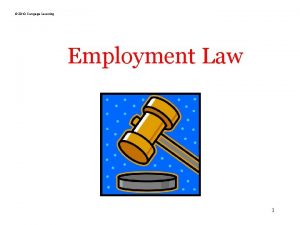CHAPTER 2010 SouthWestern a part of Cengage Learning




































- Slides: 36

CHAPTER © 2010 South-Western, a part of Cengage Learning All rights reserved. 5 Positioning Eighth Edition Power. Point Presentation by Charlie Cook The University of West Alabama

Chapter Objectives After reading this chapter you should be able to: 1. Appreciate the concept and practice of brand positioning. 2. Explain that positioning involves the creation of meaning and that meaning is a constructive process involving the use of signs and symbols. 3. Give details about how brand marketers position their brands by drawing meaning from the culturally constituted world. 4. Describe how brands are positioned in terms of various types of benefits and attributes. 5. Explicate two perspectives that characterize how consumers process information and describe the relevance of each perspective for brand positioning. © 2010 South-Western, a part of Cengage Learning. All rights reserved. 5– 2

Introduction: Brand Positioning • Positioning Ø The key feature, benefit, or image that the brand stands for in the target audience’s collective mind • Positioning Statement Ø The central idea that encapsulates a brand’s meaning and distinctiveness vis-à-vis competitive brands © 2010 South-Western, a part of Cengage Learning. All rights reserved. 5– 3

Positioning in Theory: A Matter of Creating Meaning • Semiotics Ø The study of signs and the analysis of meaning- producing events • Semiotics Perspective Ø Meaning is a constructive process determined by: The message source’s choice of communication elements v The receiver’s unique social-cultural background and mind-set at the time of exposure to a message v © 2010 South-Western, a part of Cengage Learning. All rights reserved. 5– 4

© 2010 South-Western, a part of Cengage Learning. All rights reserved. 5– 5

Positioning in Theory: A Matter of Creating Meaning (cont’d) • A Sign Ø Stimuli that are used to evoke an intended meaning in another person Ø Is words, visualizations, tactile objects, and anything else perceivable by the senses Ø Has a constructed meaning to the receiver (interpreter) that is both idiosyncratic and context dependent • Marcom’s Positioning Goal Ø To have consumers will interpret messages exactly as they are intended © 2010 South-Western, a part of Cengage Learning. All rights reserved. 5– 6

Figure 5. 1 The Thumbs-Up Sign © 2010 South-Western, a part of Cengage Learning. All rights reserved. 5– 7

The Meaning of Meaning • Meanings Ø Are thoughts and feelings evoked within a person when presented with a sign in a particular context Ø Are internal responses people hold for external stimuli • Perceptual Fields Ø Represent the sum total of a person’s experiences that are stored in memory Ø Facilitate effective marcom when there is commonality in both the sender’s and the receiver’s fields of experience © 2010 South-Western, a part of Cengage Learning. All rights reserved. 5– 8

Meaning Transfer: From Culture to Object to Consumer • Socialization Ø The process through which people learn cultural values, form beliefs, and become familiar with the physical manifestations, or artifacts, of these values and beliefs • Advertising in a Culturally Constituted World Ø Advertisements become texts to be interpreted by consumers from within their socio-cultural context Ø Marcom attempts to use the meaning of well-known symbols to transfer that meaning to their brand © 2010 South-Western, a part of Cengage Learning. All rights reserved. 5– 9

Figure 5. 2 V 8 Advertisements Illustrating Contextual Meaning © 2010 South-Western, a part of Cengage Learning. All rights reserved. 5– 10

Positioning in Practice: The Nuts and Bolts • Brand Positioning Ø Is essential to a successful Marcom program • Effective Positioning Statement Ø Conveys a consistent message Ø Defines a brand’s competitive advantage Ø Motivates customers to action • Positioning Concept Ø “Positioned in” the consumer’s mind Ø “Positioned against” competing brands © 2010 South-Western, a part of Cengage Learning. All rights reserved. 5– 11

Figure 5. 3 Outcomes of Proposed Positioning © 2010 South-Western, a part of Cengage Learning. All rights reserved. 5– 12

Proposed Positioning Outcomes Promote Competitors • Position does not reflect competitive advantage • Position represents important reason for brand selection decisions • Any effort would serve other brand selection decisions in same category Loser • Brand possesses no competitive advantage • Positioning basis does not motivate consumers to want the brand © 2010 South-Western, a part of Cengage Learning. All rights reserved. Winner • Positioned on a product feature or benefit that has an advantage over competitors • Positioning gives consumers a persuasive reason for trying the brand SUTR • Position represents a competitive advantage for a trivial product feature or benefit • Position does not give compelling reasons to want the brand • Any effort will be hard work with little progress 5– 13

Figure 5. 4 A Framework for Brand Positioning © 2010 South-Western, a part of Cengage Learning. All rights reserved. 5– 14

Benefit Positioning Appealing to Consumer Needs Functional Needs Symbolic Needs © 2010 South-Western, a part of Cengage Learning. All rights reserved. Experiential Needs 5– 15

Categories of Consumer Needs Functional Needs Symbolic Needs Experiential Needs Positioning communicates that the brand’s benefits are capable of solving consumers’ consumption-related problems Positioning attempts to associate brand ownership with a desired group, role, or self-image Positioning promotes brand’s extraordinary sensory value or rich potential for cognitive stimulation © 2010 South-Western, a part of Cengage Learning. All rights reserved. 5– 16

Figure 5. 5 Croc Advertisement Illustrating Appeal to Functional Needs © 2010 South-Western, a part of Cengage Learning. All rights reserved. 5– 17

Figure 5. 6 Dove Advertisement Illustrating Appeal to Experiential Needs © 2010 South-Western, a part of Cengage Learning. All rights reserved. 5– 18

Attribute Positioning Product-Related © 2010 South-Western, a part of Cengage Learning. All rights reserved. Non-Product Related: Usage and User Imagery 5– 19

Figure 5. 8 Ralph Lauren Advertisement Illustrating Positioning Based on User Imagery © 2010 South-Western, a part of Cengage Learning. All rights reserved. 5– 20

Figure 5. 7 Highlander Advertisement Illustrating Product-Related Attribute Positioning © 2010 South-Western, a part of Cengage Learning. All rights reserved. 5– 21

Repositioning a Brand Increase competitiveness Why Reposition a Brand? Extend product life cycle Refresh brand image Enter new market segments © 2010 South-Western, a part of Cengage Learning. All rights reserved. 5– 22

Implementing Positioning: Know Thy Consumer • Consumer Processing Model (CPM) Ø Information and choice are a rational, cognitive, systematic and reasoned process • Hedonic, Experiential Model (HEM) Ø Consumers’ processing of marcom messages and behavior are driven by emotions in pursuit of fun, fantasies, and feeling © 2010 South-Western, a part of Cengage Learning. All rights reserved. 5– 23

Figure 5. 9 Comparison of the CPM and HEM Models © 2010 South-Western, a part of Cengage Learning. All rights reserved. 5– 24

The Consumer Processing Model (CPM) Stage 1: Being exposed to information Stage 2: Paying attention Stage 3: Comprehending attended information Stage 4: Agreeing with comprehended information Stage 5: Retaining accepted information in memory Stage 6: Retrieving information from memory Stage 7: Deciding from alternatives Stage 8: Acting on the basis of the decision © 2010 South-Western, a part of Cengage Learning. All rights reserved. 5– 25

CPM Model Stages Stage 1: Being Exposed to information Stage 2: Paying Attention Stage 3: Comprehending information • Is a necessary but insufficient for communication success—truth effect” of repeated exposure to a message • Is a function managerial decisions about marcom budget size and choice of media and vehicles • Is a deliberate focus on and consideration of a message • Involves allocating processing capacity in a selective fashion • Is drawn to messages relevant and of interest to current goals • Is understanding and creating meaning out of stimuli and symbols • Involves perceptual encoding (feature analysis and active analysis) to interpret stimuli • May result in an idiosyncratic interpretation or miscomprehension © 2010 South-Western, a part of Cengage Learning. All rights reserved. 5– 26

Figure 5. 10 Humorous Illustration of Selective Perception © 2010 South-Western, a part of Cengage Learning. All rights reserved. 5– 27

Miscomprehension Reasons for Miscomprehension Misleading or Unclear Messages Biased Preconceptions © 2010 South-Western, a part of Cengage Learning. All rights reserved. Time Pressures and Noise 5– 28

CPM Model Stages (cont’d) Stage 4: Agreeing with Comprehended Information Stages 5 & 6: Retention and Search and Retrieval of Stored Information • Does not ensure that the message influences consumers’ behavior • Depends on credibility of the message • Depends on compatibility of the information with values important to the consumer • Involves the related issues of what consumers remember (recognize and recall) about marketing stimuli • Shows how consumers access and retrieve information when in the process of choosing among product alternatives. © 2010 South-Western, a part of Cengage Learning. All rights reserved. 5– 29

Elements of Memory Sensory Receptors Sensory Stores (SS) The marketer’s job is to provide positively valued information that consumers will store in LTM Short-Term Memory (STM) Long-Term Memory (LTM) © 2010 South-Western, a part of Cengage Learning. All rights reserved. 5– 30

Figure 5. 11 Consumer’s Knowledge Structure for the Volkswagen Beetle © 2010 South-Western, a part of Cengage Learning. All rights reserved. 5– 31

Types of Learning • Strengthening Memory Concept Linkages Ø Repeating product claims Ø Being creative in conveying a product’s features Ø Presenting claims in a more concrete fashion • Establishing New Linkages Ø Marcom can build strong, favorable, and unique associations between the brand its features and benefits © 2010 South-Western, a part of Cengage Learning. All rights reserved. 5– 32

Figure 5. 12 Illustration of an Effort to Strengthen a Linkage between a Brand Its Benefits © 2010 South-Western, a part of Cengage Learning. All rights reserved. 5– 33

Search and Retrieval of Information • Learned Information Ø Impacts consumer choice behavior when it is searched and retrieved • Retrieval of Stored Information Ø Is facilitated when new information is linked with another well known concept that is easily accessed • Dual-Coding Theory Ø Pictures are represented in memory in both verbal and visual form Ø Words are less likely to have visual representations © 2010 South-Western, a part of Cengage Learning. All rights reserved. 5– 34

The Hedonic, Experiential Model (HEM) • The HEM Perspective Ø The CPM and HEM models are not mutually exclusive —consumers can be both rational and self-involved in their decision-making processes • HEM Communications Ø Generate images, fantasies, and positive emotions and feelings about brands that consumers interpret idiosyncratically Ø Emphasize nonverbal content or emotionally provocative words to connect consumers to brands © 2010 South-Western, a part of Cengage Learning. All rights reserved. 5– 35

Figure 5. 13 Illustration of an HEM-Oriented Advertisement © 2010 South-Western, a part of Cengage Learning. All rights reserved. 5– 36
 2010 cengage learning
2010 cengage learning Chapter 13 medical math assignment sheet cengage learning
Chapter 13 medical math assignment sheet cengage learning Chapter 7:10 respitory system
Chapter 7:10 respitory system 2009 delmar cengage learning
2009 delmar cengage learning Chapter 5 learning exercises medical terminology
Chapter 5 learning exercises medical terminology Cengage learning heart diagram
Cengage learning heart diagram South-western cengage learning
South-western cengage learning 2009 delmar cengage learning
2009 delmar cengage learning Cengage learning heart diagram
Cengage learning heart diagram Introduction to medical terminology chapter 1
Introduction to medical terminology chapter 1 Cengage learning australia
Cengage learning australia Graphing tpr
Graphing tpr Cengage learning
Cengage learning Cengage learning
Cengage learning Wadsworth cengage learning
Wadsworth cengage learning Cengage learning
Cengage learning Cengage learning plant cell
Cengage learning plant cell Cengage learning
Cengage learning Cengage learning
Cengage learning Brooks cole cengage learning
Brooks cole cengage learning 2014 cengage learning accounting answers
2014 cengage learning accounting answers Cengage chapter 7
Cengage chapter 7 Cengage learning
Cengage learning Cengage learning
Cengage learning 2009 delmar cengage learning
2009 delmar cengage learning Cengage learning
Cengage learning Chapter 10 cultural diversity
Chapter 10 cultural diversity Cengage learning
Cengage learning 2012 cengage learning
2012 cengage learning Solomon four group design
Solomon four group design Cengage learning psychology
Cengage learning psychology Course technology cengage learning
Course technology cengage learning Course technology cengage learning
Course technology cengage learning Course technology cengage learning
Course technology cengage learning Course technology cengage learning
Course technology cengage learning 2016 cengage learning
2016 cengage learning Delmar cengage learning instructor resources
Delmar cengage learning instructor resources
